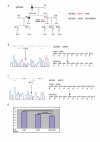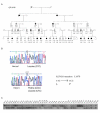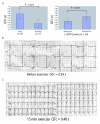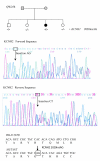Protective effect of KCNH2 single nucleotide polymorphism K897T in LQTS families and identification of novel KCNQ1 and KCNH2 mutations
- PMID: 18808722
- PMCID: PMC2570672
- DOI: 10.1186/1471-2350-9-87
Protective effect of KCNH2 single nucleotide polymorphism K897T in LQTS families and identification of novel KCNQ1 and KCNH2 mutations
Abstract
Background: KCNQ1 and KCNH2 are the two most common potassium channel genes causing long QT syndrome (LQTS), an inherited cardiac arrhythmia featured by QT prolongation and increased risks of developing torsade de pointes and sudden death. To investigate the disease expressivity, this study aimed to identify mutations and common variants that can modify LQTS phenotype.
Methods: In this study, a cohort of 112 LQTS families were investigated. Among them two large LQTS families linkage analysis with markers spanning known LQTS genes was carried out to identify the specific gene for mutational analysis. All exons and exon-intron boundaries of KCNH2 and KCNQ1 were sequenced for mutational analysis.
Results: LQTS-associated mutations were identified in eight of 112 families. Two novel mutations, L187P in KCNQ1 and 2020insAG in KCNH2, were identified. Furthermore, in another LQTS family we found that KCNH2 mutation A490T co-segregated with a common SNP K897T in KCNH2. KCNH2 SNP K897T was reported to exert a modifying effect on QTc, but it remains controversial whether it confers a risk or protective effect. Notably, we have found that SNP K897T interacts with mutation A490T in cis orientation. Seven carriers for A490T and the minor allele T of SNP K897T showed shorter QTc and fewer symptoms than carriers with A490T or A490P (P < 0.0001).
Conclusion: Our family-based approach provides support that KCNH2 SNP K897T confers a protective effect on LQTS patients. Our study is the first to investigate the effect of SNP K897T on another KCNH2 mutation located in cis orientation. Together, our results expand the mutational and clinical spectrum of LQTS and provide insights into the factors that determine QT prolongation associated with increased risk of ventricular tachycardia and sudden death.
Figures




Similar articles
-
[Novel mutations of potassium channel KCNQ1 S145L and KCNH2 Y475C genes in Chinese pedigrees of long QT syndrome].Zhonghua Nei Ke Za Zhi. 2006 Jun;45(6):463-6. Zhonghua Nei Ke Za Zhi. 2006. PMID: 16831322 Chinese.
-
KCNQ1 and KCNH2 mutations associated with long QT syndrome in a Chinese population.Hum Mutat. 2002 Dec;20(6):475-6. doi: 10.1002/humu.9085. Hum Mutat. 2002. PMID: 12442276 Free PMC article.
-
Allelic dropout in long QT syndrome genetic testing: a possible mechanism underlying false-negative results.Heart Rhythm. 2006 Jul;3(7):815-21. doi: 10.1016/j.hrthm.2006.03.016. Epub 2006 Mar 16. Heart Rhythm. 2006. PMID: 16818214
-
Genetics of long QT syndrome.Methodist Debakey Cardiovasc J. 2014 Jan-Mar;10(1):29-33. doi: 10.14797/mdcj-10-1-29. Methodist Debakey Cardiovasc J. 2014. PMID: 24932360 Free PMC article. Review.
-
A personalized approach to long QT syndrome.Curr Opin Cardiol. 2019 Jan;34(1):46-56. doi: 10.1097/HCO.0000000000000587. Curr Opin Cardiol. 2019. PMID: 30394905 Review.
Cited by
-
Influence of genetic modifiers on sudden cardiac death cases.Int J Legal Med. 2018 Mar;132(2):379-385. doi: 10.1007/s00414-017-1739-7. Epub 2017 Dec 6. Int J Legal Med. 2018. PMID: 29214556
-
Relationship of common candidate gene variants to electrocardiographic T-wave peak to T-wave end interval and T-wave morphology parameters.Heart Rhythm. 2010 Jul;7(7):898-903. doi: 10.1016/j.hrthm.2010.03.002. Epub 2010 Mar 4. Heart Rhythm. 2010. PMID: 20215044 Free PMC article.
-
KCNQ1 p.L353L affects splicing and modifies the phenotype in a founder population with long QT syndrome type 1.J Med Genet. 2017 Jun;54(6):390-398. doi: 10.1136/jmedgenet-2016-104153. Epub 2017 Mar 6. J Med Genet. 2017. PMID: 28264985 Free PMC article.
-
The Linkage Phase of the Polymorphism KCNH2-K897T Influences the Electrophysiological Phenotype in hiPSC Models of LQT2.Front Physiol. 2021 Dec 16;12:755642. doi: 10.3389/fphys.2021.755642. eCollection 2021. Front Physiol. 2021. PMID: 34992545 Free PMC article.
-
Where genotype is not predictive of phenotype: towards an understanding of the molecular basis of reduced penetrance in human inherited disease.Hum Genet. 2013 Oct;132(10):1077-130. doi: 10.1007/s00439-013-1331-2. Epub 2013 Jul 3. Hum Genet. 2013. PMID: 23820649 Free PMC article. Review.
References
-
- Roden DM, Lazzara R, Rosen M, Schwartz PJ, Towbin J, Vincent GM. Multiple mechanisms in the long-QT syndrome. Current knowledge, gaps, and future directions The SADS Foundation Task Force on LQTS. Circulation. 1996;94:1996–2012. - PubMed
-
- Chen S, Zhang L, Bryant RM, Vincent GM, Flippin M, Lee JC, Brown E, Zimmerman F, Rozich R, Szafranski P, Oberti C, Sterba R, Marangi D, Tchou PJ, Chung MK, Wang Q. KCNQ1 mutations in patients with a family history of lethal cardiac arrhythmias and sudden death. Clin Genet. 2003;63:273–282. doi: 10.1034/j.1399-0004.2003.00048.x. - DOI - PMC - PubMed
-
- Zhang L, Timothy KW, Vincent GM, et al. The spectrum of ST-T wave patterns and repolarization parameters in congenital long QT syndrome: ECG findings identify genotype. Circulation. 2000;102:2849–2855. - PubMed
-
- Wang Q, Curren ME, Splawski I, Burn TC, Millholland JM, VanRaay TJ, Shen J, Timothy KW, Vincent GM, de Jager T, Schwartz PJ, Towbin JA, Moss AJ, Atkinson DL, Landes GM, Connors TD, Keating MT. Positional cloning of a novel potassium channel gene: KVLQT1 mutations cause cardiac arrhythmias. Nature Genet. 1996;12:17–23. doi: 10.1038/ng0196-17. - DOI - PubMed
Publication types
MeSH terms
Substances
Grants and funding
LinkOut - more resources
Full Text Sources

